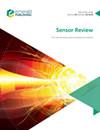A multisensor fusion algorithm of indoor localization using derivative Euclidean distance and the weighted extended Kalman filter
IF 1.4
4区 工程技术
Q3 INSTRUMENTS & INSTRUMENTATION
引用次数: 2
Abstract
Purpose At present, smartphones are embedded with accelerometers, gyroscopes, magnetometers and WiFi sensors. Most researchers have delved into the use of these sensors for localization. However, there are still many problems in reducing fingerprint mismatching and fusing these positioning data. The purpose of this paper is to improve positioning accuracy by reducing fingerprint mismatching and designing a weighted fusion algorithm. Design/methodology/approach For the problem of magnetic mismatching caused by singularity fingerprint, derivative Euclidean distance uses adjacent fingerprints to eliminate the influence of singularity fingerprint. To improve the positioning accuracy and robustness of the indoor navigation system, a weighted extended Kalman filter uses a weighted factor to fuse multisensor data. Findings The scenes of the teaching building, study room and office building are selected to collect data to test the algorithm’s performance. Experiments show that the average positioning accuracies of the teaching building, study room and office building are 1.41 m, 1.17 m, and 1.77 m, respectively. Originality/value The algorithm proposed in this paper effectively reduces fingerprint mismatching and improve positioning accuracy by adding a weighted factor. It provides a feasible solution for indoor positioning.基于导数欧氏距离和加权扩展卡尔曼滤波的室内定位多传感器融合算法
目前,智能手机内嵌加速度计、陀螺仪、磁力计和WiFi传感器。大多数研究人员已经深入研究了这些传感器在定位中的应用。然而,在减少指纹不匹配和融合这些定位数据方面还存在许多问题。本文的目的是通过减少指纹不匹配和设计一种加权融合算法来提高定位精度。针对奇点指纹引起的磁不匹配问题,导数欧氏距离利用相邻指纹消除奇点指纹的影响。为了提高室内导航系统的定位精度和鲁棒性,加权扩展卡尔曼滤波采用加权因子对多传感器数据进行融合。结果选取教学楼、自习室和办公楼场景进行数据采集,测试算法的性能。实验表明,教学楼、自习室和办公楼的平均定位精度分别为1.41 m、1.17 m和1.77 m。独创性/价值本文提出的算法通过增加加权因子,有效地减少了指纹不匹配,提高了定位精度。为室内定位提供了一种可行的解决方案。
本文章由计算机程序翻译,如有差异,请以英文原文为准。
求助全文
约1分钟内获得全文
求助全文
来源期刊

Sensor Review
工程技术-仪器仪表
CiteScore
3.40
自引率
6.20%
发文量
50
审稿时长
3.7 months
期刊介绍:
Sensor Review publishes peer reviewed state-of-the-art articles and specially commissioned technology reviews. Each issue of this multidisciplinary journal includes high quality original content covering all aspects of sensors and their applications, and reflecting the most interesting and strategically important research and development activities from around the world. Because of this, readers can stay at the very forefront of high technology sensor developments.
Emphasis is placed on detailed independent regular and review articles identifying the full range of sensors currently available for specific applications, as well as highlighting those areas of technology showing great potential for the future. The journal encourages authors to consider the practical and social implications of their articles.
All articles undergo a rigorous double-blind peer review process which involves an initial assessment of suitability of an article for the journal followed by sending it to, at least two reviewers in the field if deemed suitable.
Sensor Review’s coverage includes, but is not restricted to:
Mechanical sensors – position, displacement, proximity, velocity, acceleration, vibration, force, torque, pressure, and flow sensors
Electric and magnetic sensors – resistance, inductive, capacitive, piezoelectric, eddy-current, electromagnetic, photoelectric, and thermoelectric sensors
Temperature sensors, infrared sensors, humidity sensors
Optical, electro-optical and fibre-optic sensors and systems, photonic sensors
Biosensors, wearable and implantable sensors and systems, immunosensors
Gas and chemical sensors and systems, polymer sensors
Acoustic and ultrasonic sensors
Haptic sensors and devices
Smart and intelligent sensors and systems
Nanosensors, NEMS, MEMS, and BioMEMS
Quantum sensors
Sensor systems: sensor data fusion, signals, processing and interfacing, signal conditioning.
 求助内容:
求助内容: 应助结果提醒方式:
应助结果提醒方式:


